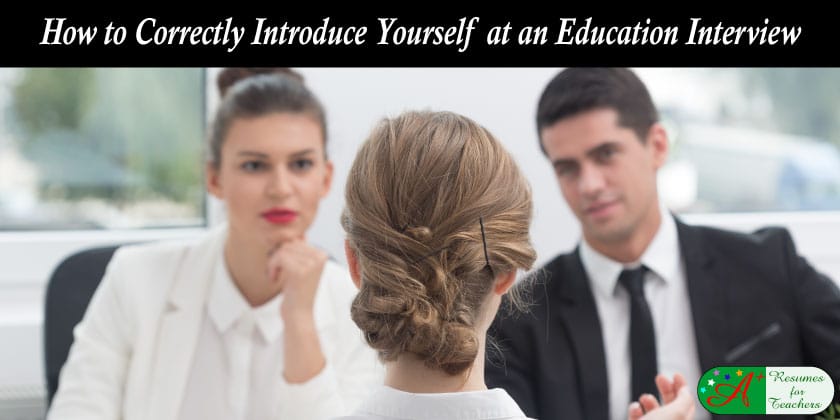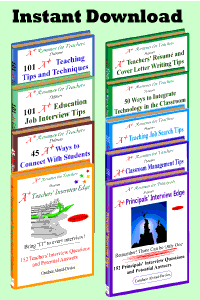How you introduce yourself at a job interview could make or break your performance. The first five minutes of your teacher job interview often set the stage for the entire education interview process. Making a positive first impression can ensure the rest of your interview flows smoothly, becomes more enjoyable, and helps you feel confident and relaxed.
Mastering the First Five Minutes of Your Education Interview
Dressing for Success
What you wear to a job interview can be as important as what you say. Like it or not, we are a visual society, and first impressions are often based on appearance. Your attire conveys a message about who you are, what kind of employee you will be, and how well you might fit into the school’s culture.
Aim for professionalism and alignment with the role when dressing for an education interview. For example, a tailored blazer, modest blouse, dress pants, or a knee-length skirt are often appropriate. Mistakes like chewing gum, showcasing distracting piercings or tattoos, or wearing overly casual outfits like jeans, tracksuits, or spike heels can create a negative impression. Instead, opt for a polished and conservative appearance that reflects the professional environment of a school setting.
Example:
A candidate interviewing for a high school teaching position could wear a navy blazer, white shirt, and gray dress pants paired with simple jewelry and neat shoes. This outfit communicates respect for the role and the interviewers.
Greeting the Interviewer or Interview Panel
Though it seems straightforward, greeting the interviewer is something many nervous candidates overlook. First impressions start the moment you enter the room. If you’re meeting a panel, make a point to greet each individual warmly and introduce yourself by name unless they address you first.
A firm handshake and a genuine smile help establish rapport and show confidence. If possible, address each panel member by name during the introduction. This personalized approach can make a lasting positive impression and set the tone for the interview.
Examples:
- “Good morning! My name is Emily Carter. It’s a pleasure to meet all of you. Thank you for taking the time to interview me today.”
- “Hello, I’m David Martinez. I’m thrilled to be here today to discuss the opportunity to join your team.”
- “Hi, my name is Rachel Kim. I’m very excited to share my teaching experiences and learn more about your school.”
Confident and Prepared: Your Guide to Starting an Education Interview Right
After greeting the interviewers, wait to be invited to sit. This demonstrates respect and attentiveness. Once seated, maintain good posture—sit up straight without slumping or leaning on the desk. The interviewer will likely observe your body language, so remain poised.
Be prepared for small talk or an introductory question, such as, “Can you tell us a little about your background?” This is an opportunity to highlight your experience, teaching philosophy, or enthusiasm for the role.
Examples:
- “I’ve been teaching middle school science for the past six years, and I’m passionate about making STEM subjects accessible and exciting for all students.”
- “I’ve recently completed my degree in education with a specialization in early childhood learning. I’m eager to bring my innovative lesson planning and classroom management strategies to your team.”
- “Over the last decade, I’ve taught English at various grade levels, focusing on improving literacy rates and encouraging a love of reading among students.”
Smiling and Positivity Count
A smile can ease tension for both you and the interviewers. While feeling nervous is natural, maintaining a positive demeanor can make a big difference. Avoid fidgeting, slumping, or looking down, as these behaviors may be perceived as disinterest or insecurity.
Example:
Instead of tapping your fingers or playing with a pen, keep your hands resting calmly on your lap or the table. Smile when appropriate, such as when you’re being welcomed or discussing your teaching achievements.
Eye Contact and Confidence Matter
Consistent eye contact conveys confidence and helps you connect with your interviewers. Speak clearly and with a steady tone, as mumbling or speaking too quickly can detract from your message.
Practice answering common education interview questions aloud before your interview. This will help you refine your delivery and ensure your answers are both thoughtful and concise.
Example:
If asked, “How do you handle classroom management?” you might respond:
- “I believe in creating a classroom culture built on mutual respect. For example, I establish clear expectations from day one and consistently reinforce them with positive reinforcement and redirection strategies when needed.”
Additional Examples:
- “When I’m asked about my teaching approach, I emphasize the importance of differentiated instruction to meet the diverse needs of my students.”
- “For classroom discipline, I’ve found that a mix of clear communication and restorative practices helps students stay accountable while maintaining a positive environment.”
Wrapping It Up
In conclusion, how you introduce yourself during an educational interview plays a pivotal role in shaping your success. By dressing professionally, greeting the interviewers warmly, maintaining a confident demeanor, and speaking clearly, you set the stage for a positive and engaging conversation.
Remember to highlight your unique experiences and teaching philosophy with enthusiasm and sincerity. When you leave the interview, you should feel confident that your introduction conveyed the best version of yourself as a passionate and capable educator. By mastering these strategies, you’ll make a strong first impression and increase your chances of landing your desired teaching position.


